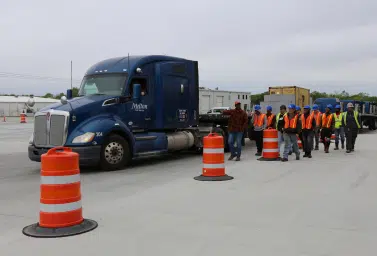
Staying Safe Driving in Construction Zones: Top 5 Tips for Drivers
If you’ve spent any time behind the wheel as a truck driver, you’d know that construction zones can be a painful part of the job.
Whether you’re running a long-haul across multiple states, or just sticking to your regional routes, navigating these fast-changing areas requires more than just patience; it requires heightened awareness and skill.
But why is it so important to know how to drive safely through construction zones?
For starters, construction zones bring a unique set of challenges that aren’t present under normal road conditions; narrow lanes, reduced speed limits, shifting traffic patterns, and unexpected stops can turn an ordinary stretch of highway into a high-risk environment. Add in uneven pavement, temporary signage, flaggers, and workers operating just a few feet away from moving traffic, and the margin for error becomes razor-thin. For truck drivers operating heavy, oversized vehicles, the stakes are even higher.
The good news? With the right approach and a solid set of safety practices, you can navigate construction zones confidently and protect not only yourself, but everyone else on the road.
In this post, we’ll cover top tips for staying safe in construction areas, because at the end of the day, safety isn’t just about compliance; it’s about making sure everyone can make it home
Here are our top 5 tips to staying safe in these zones!
1. Stay Alert at All Times!
- Many work zones require lane shifts that may feel abrupt for a large truck, so always look ahead for merging lanes and detour signs to avoid last-minute lane changes.
- Always be on the lookout for flaggers directing traffic, especially during low-visibility weather.
- Stay extra cautious near workers, especially when backing up or turning is involved. You may even need to ask for assistance if the route isn’t clear.
2. Reduce Your Speed and Follow Posted Weight Limits
- Always obey posted work zone speed limits, even if traffic appears to be clear.
- A lower speed allows for more reaction time during unexpected hazards.
- Construction areas on certain roads and bridges may reduce the weight limit of route you travel often; always have a backup route just in case.
3. Increase Your Following Distance
- Increase your following distance to at least 10 – 12 seconds behind other vehicles.
- Avoid hard braking, which could lead to dangerous situations on loose gravel or uneven pavement.
- Many accidents happen when traffic suddenly slows down or stops unexpectedly, so keep an eye on brake lights and the general flow of traffic ahead to anticipate slowdowns.

4. Be Mindful of Blind Spots and Traffic Changes
- Construction zones often have tight spaces, increasing the likelihood of vehicles sitting in your blind spots. Use your mirrors frequently to ensure everyone is safe around you.
- Some work zones may reroute truck traffic specifically due to weight or road width limits. Make sure to follow any designated truck detours.
- Check construction updates before heading out to avoid unexpected delays; this is best done during your pre-trip planning time.
5. Minimize Distractions and Stay Focused!
- No phone use or distractions- give construction zones your full attention!
- Minimize in-cab distractions like adjusting your radio or GPS while driving.
- Make sure your personal gear is secured prior to your trip. Road work can seriously jostle your cab, causing loose items to fall and become dangerous distractions.
How Does Melton Train Drivers in Safe Driving Behavior?
Melton Truck Lines is deeply invested in the safety of our drivers. From a thorough, hands-on training process during our 8-day pre-hire evaluation, to an extensive 3-week training program with a certified Melton Trainer, we want our drivers to start their journey off on the best foot possible.
This commitment continues through Melton’s 24/7 driver support, ensuring that help and guidance are always just a phone call away. Annual safety blitzes reinforce key safety practices and keep safety top-of-mind year-round. Plus, with advanced safety equipment, Melton not only promotes accountability but also provides valuable coaching tools that help drivers improve continuously.
Melton’s focus on safety creates a culture where drivers feel supported, prepared, and confident behind the wheel. If you’re ready to work for a company that prioritizes safe driving, you can learn more about our flatbed driving jobs here.
